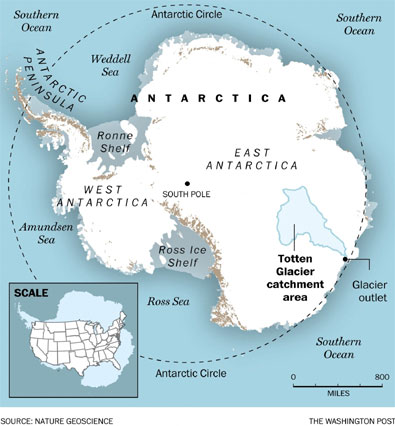Update May 20: Scientists expect Larsen C to break off within the next few years.
—-
Amidst all the good news we write about, from China’s leadership on wind to India’s massive entry into solar, is the backdrop of rapidly advancing climate change – causing so many changes it’s hard to keep track of them all.
While the focus is often on the Arctic – which could be completely ice-free in 25 years – Antarctica is also becoming a scary place for scientists that are measuring the changes.
In January, satellite images showed a giant crack in the Larsen C ice shelf grew by 12 miles last year. If it breaks off, an iceberg between the size of Rhode Island and Delaware – 1700 to 2500 square miles would vanish into the sea, as did Larsen B in 2002, Paul Holland, a British Antarctic scientist, told Associated Press (AP).
It was just a few years ago that scientists thought Antarctica’s ice was holding steady, but it’s not. While surface ice is growing in East Antarctica because of cooler water and air, it isn’t compensating for the amount of melting in West Antarctica, now called "unstoppable."
Over the last 10 years, ice melt has risen 70%, and about 18% of West Antarctica’s ice is gone, according to satellite data.
Even in East Antarctica the water is warming, scientists say in Nature Geoscience, causing its Totten Glacier to quickly melt. "That’s alarming, because the glacier holds back a much more vast catchment of ice that, were its vulnerable parts to flow into the ocean, could produce sea level rise of more than 11 feet – comparable to the impact from a loss of the West Antarctica ice sheet. And that’s "a conservative lower limit," lead author Jamin Greenbaum at the University of Texas/ Austin told Washington Post.
Melting "is going way faster than anyone had thought. It’s a red flag," Eric Rignot, an ice scientist at NASA, told AP.

Melting isn’t as easy to see on Greenland and the Arctic because until a massive iceberg breaks off it is quietly weakening from warmer water underneath. Why? Because climate change is shifting wind patterns allowing warmer water to reach the continent.
"Changing the climate of the Earth or thinning glaciers is fine as long as you don’t do it too fast. And right now we are doing it as fast as we can. It’s not good. We have to stop it; or we have to slow it down as best as we can," says Rignot.
Sea levels will rise the most in the Northern Hemisphere because of gravity – 25% higher or more in the US than the global average, says Washington Post.
Check out VICE on HBO – the first episode of this year’s series debuts March 6, 11 PM. It’s about sea level rise, with excursions to the West Antarctic ice sheet and Bangladesh.
Jet Stream Changing in the North
Air temperatures in the Arctic continue to rise at twice the rate of global air temperatures, says NOAA in its 2014 Arctic Report Card, and water temperature is also increasing.
Right now, the ice cap is near its all-time low for this time of year.
This could affect the pattern of the high-altitude polar jet stream for years ahead, making frigid cold and record snow the new normal for the Midwest and Eastern part of the US and northern Europe.

The jet stream forms from cold Arctic air clashing with warmer air from the south, but with less difference between those temperatures now, the river of air is weakening, according to scientists’ measurements.
Read our article, Researchers Zero In On Climate Change Timeframe.
Read the Washington Post article, The melting of Antarctica was already really bad. It just got worse:
